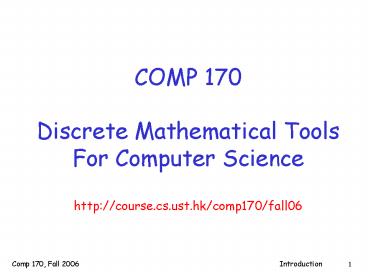COMP 170 Discrete Mathematical Tools For Computer Science http:course'cs'ust'hkcomp170fall06 - PowerPoint PPT Presentation
1 / 13
Title:
COMP 170 Discrete Mathematical Tools For Computer Science http:course'cs'ust'hkcomp170fall06
Description:
Introduction. 1. Comp 170, Fall 2006. COMP 170. Discrete Mathematical Tools ... mistakes or just think that something's confusing, please email the instructor ... – PowerPoint PPT presentation
Number of Views:124
Avg rating:3.0/5.0
Title: COMP 170 Discrete Mathematical Tools For Computer Science http:course'cs'ust'hkcomp170fall06
1
COMP 170 Discrete Mathematical Tools For
Computer Sciencehttp//course.cs.ust.hk/comp170/
fall06
2
Personnel
- Instructors
- L1 Mordecai Golin golin_at_cs.ust.hk
- L2 Dit-Yan Yeung dyyeung_at_cs.ust.hk
- TAs Please see http//course.cs.ust.hk/comp170
/fall06/
3
Marking Scheme
- 10 short weekly homeworks
- (distributed on Tuesday should be
submitted the following Tuesday) - marked on scale of 0-2
- 0missing/all wrong 2 mostly
correct - 25 midterm 1
- (tentatively) Thursday, October 5,
7-830PM - covers first third of class
material - 25 midterm 2
- (tentatively) Thursday, November 2,
7-830PM - covers second third of class
material - 40 final
- covers entire semesters material
4
Class material
- Text book You must have a copy!
- Discrete Math for Computer Science
- K. Bogart, C. Stein and R.L. Drysdale
- Key College Publishing, 2005
- Main ideas will be covered in class but some
details might be skipped. You are responsible
for all material in assigned sections of book,
even if they are not taught in lecture - Most material, e.g., lecture notes, assignments,
exam solutions, will be available on class web
site http//course.cs.ust.hk/comp170/fall06 - Please download lecture notes before class and
bring them to class with you
5
Tutorials
- There will be a tutorial once a week
- During this time the Teaching Assistant (TA) will
explain the solutions to the homework you just
submitted. - The TA may also review class material that you
find confusing. If you would like this, please
email your TA at least a day in advance of your
tutorial, stating what you would like to have
reviewed.
6
Interaction
- Please ask questions in class.
- Rule of thumb if youre having trouble
understanding something, then at least 50 of the
class is also having trouble - theyll be very happy if you ask for more
explanation - Out of class
- Office-hours (of instructor, coordinator, TAs)
- will be posted shortly
- For out of office-hour meetings, please send
email. - Questions may be sent by email or posted on
course - newsgroup hkust.cs.class.170 (see class web
site for access - information)
- Note emailed Q/As might be posted on the
class web site or the newsgroup to help other
students
7
- This is a relatively NEW class
- Until last year, students had to take MATH 132
Discrete Math without CS orientation - This new class teaches discrete math motivated by
CS examples - Since its new, this class is still a work in
progress - Your feedback is strongly requested and will
shape further redesign of the course. - Is it too hard/easy, fast/slow?
- Does it assume background you dont have?
- Too much work or more drilling needed?
- Etc. .
8
- Since this is still a new course there will
probably still be a few errors in the drafts of
materials posted on the web-site. - If you find mistakes or just think that
somethings confusing, please email the
instructor or class coordinator - Your classmates and future students
- will thank you
- All changes to the notes will be noted in the
revision log on the class web-site. Check the
revision log regularly to make sure that you have
the most up-to-date versions of the notes
9
The HKUST Academic Honor Codehttp//www.ust.hk/vp
aao/integrity
- Honesty and integrity are central tothe
academic work of HKUST. Students of the
University must observe and upholdthe highest
standards ofacademic integrity and honesty in
all the workthey do throughout their program of
study. - As members of the University community,students
have the responsibility to help maintainthe
academic reputation of HKUSTin its academic
endeavors. - Sanctions will be imposed on students,if they
are found to have violated the regulationsgoverni
ng academic integrity and honesty.
10
Intellectual Honesty and Plagiarism
- All work submitted for grading, e.g.,
assignments, must be your own. - You are permitted to discuss problems with other
students but you must write-up all solutions by
yourself in your own words. - If you got the main idea for a solution from
another student or a web-site you must
acknowledge that source in your submission. - Submission of non-acknowledged material will be
considered as plagiarism and dealt with under
the university policy for cheating.
11
- Another reason to do your
- assignments by yourself
- Many exam questions will be modified versions of
homework questions. If you dont train on the
homeworks, you might have real trouble on the
exams.
12
L1 vs. L2
- L1 and L2 will cover the same general material,
share the same assignments and write the same
exams. - L1 and L2 will be graded together
- (using the same grading curve)
- Material covered is a function of class
understanding a lecture might go faster/slower
in different sections depending upon student
feedback. - So, it is not guaranteed, that the same material
will be covered on the same day in both L1 and L2.
13
Topics
- Counting
- e.g., How many computer passwords exist?
- How fast is a particular computer program?
- Cryptography and Number Theory
- e.g., Public-Key cryptography (the basis of all
electronic commerce) - Proofs, Induction and Recursion
- e.g., How can you be sure that something works
- Probability
- e.g., Computer Networking Protocols to share
channels (wireless) - Graphs
- e.g., modeling the Internet, (JUPAS)

